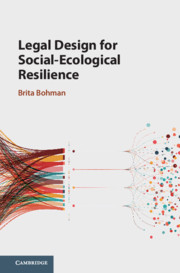Book contents
- Legal Design for Social-Ecological Resilience
- Legal Design for Social-Ecological Resilience
- Copyright page
- Contents
- Preface and Acknowledgments
- Table of Treaties and International Instruments
- Table of EU Law
- Table of Cases
- Abbreviations
- 1 Introduction
- 2 Environmental Law
- 3 Law and Governance
- 4 Defining Features for Resilience Governance
- 5 Adaptivity, Flexibility and Transformability
- 6 Multidimensional and Polycentric Structures
- 7 Stakeholders and Structures for Participation
- 8 Operationalization, Monitoring, Compliance and Trust Building
- 9 Conclusions – Effective Legal Design for Resilience Governance
- References
- Index
5 - Adaptivity, Flexibility and Transformability
Published online by Cambridge University Press: 10 March 2021
- Legal Design for Social-Ecological Resilience
- Legal Design for Social-Ecological Resilience
- Copyright page
- Contents
- Preface and Acknowledgments
- Table of Treaties and International Instruments
- Table of EU Law
- Table of Cases
- Abbreviations
- 1 Introduction
- 2 Environmental Law
- 3 Law and Governance
- 4 Defining Features for Resilience Governance
- 5 Adaptivity, Flexibility and Transformability
- 6 Multidimensional and Polycentric Structures
- 7 Stakeholders and Structures for Participation
- 8 Operationalization, Monitoring, Compliance and Trust Building
- 9 Conclusions – Effective Legal Design for Resilience Governance
- References
- Index
Summary
Adaptivity, flexibility, and transformability are fundamental features of resilience governance. These features represent the need for governance to match the constant movements of the ecosystem and the effects of pressures on the ecosystem. It is also through adaptive and flexible features that transformability can be created. Adaptive or flexible mechanisms within law matching such governance features, could be described as legal structures and measures that create space for adaptive procedures and flexible responses also within the legal regime. However, it must be noted that law could also create a kind of resistance to flexible changes in the social-ecological system. This could be regarded as one main function connected to the institutional structure and the social resilience that law creates, where stability over time and the potential to anticipate and prevent certain developments are central. International and EU law can be seen as rather adaptive and flexible in their inherent design.
Keywords
- Type
- Chapter
- Information
- Legal Design for Social-Ecological Resilience , pp. 72 - 89Publisher: Cambridge University PressPrint publication year: 2021

